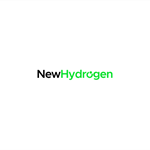Dr. Will Eckenhoff discussed his research on copper catalyzed atom transfer radical addition chemistry and the challenges of transitioning to a hydrogen-based economy
SANTA CLARITA, Calif., March 12, 2024 (GLOBE NEWSWIRE) -- NewHydrogen, Inc. (OTCMKTS:NEWH), the developer of a breakthrough technology that uses clean energy and water to produce the world’s cheapest green hydrogen, today announced that in a recent podcast the Company’s CEO Steve Hill spoke with Will Eckenhoff, Associate Professor of Chemistry and Chair of Environmental Studies at Rhodes College.
During the discussion, Dr. Eckenhoff described his research about identifying catalysts for the reduction reaction of splitting water into hydrogen and oxygen, leading to a new paper accepted for publication in Inorganic Chemistry. He also detailed the challenges they faced, including the need to perfect the synthesis and the impact of Covid-19 on the research process.
Regarding obstacles in hydrogen adoption, Dr. Eckenhoff said, “There are challenges of transitioning to a hydrogen-based economy, especially in the context of vehicle electrification. There is the issue of recharge times and the need for efficient hydrogen production methods that don't rely on fossil fuels.” The conversation also touched on the potential of light-driven hydrogen production and electro catalytic hydrogen production and developing a distribution network for hydrogen.
Mr. Hill said, “There is also a need to overcome the rate-limiting factor in electrolysis and the potential of using heat to generate the necessary reaction.” Dr. Eckenhoff concurred that generating hydrogen locally using solar energy could be a disruptive technology.
They discussed the potential applications and challenges of battery technology and hydrogen fuel cells in vehicles, and they concurred that electric vehicles are suitable for short commutes due to their range, while hybrid technology or hydrogen fuel cells might be more appropriate for long-distance trucking. The discussion also touched on the recharging times, which can be a drawback for long-distance travel. They agreed that new technologies will find a niche as they mature and solve particular problems. The conversation concluded with a discussion on the future of energy technology, with a potential focus on fusion energy and the mass production of green hydrogen.
Dr. Eckenhoff received his Ph.D. in Inorganic Chemistry from Duquesne University. He is a synthetic inorganic chemist specializing in the synthesis of copper, iron, cobalt, nickel and molybdenum complexes. Research in Dr. Eckenhoff’s lab has two main projects underway. The first project investigates the design, synthesis, and testing of nickel and cobalt complexes as catalysts for hydrogen production in artificial photosynthesis. A clean and inexpensive method of producing hydrogen gas is vital for the creation of a future hydrogen economy. The second project looks at a group of Molybdenum complexes which exhibit a stunning and previously unknown solvatochromic effect, or color-change in different solvents. These compounds have potential applications in sensor technology and also enhance our understanding of polarity. Dr. Eckenhoff is listed as Google Scholar at https://scholar.google.com/citations?user=2vwrl6kAAAAJ.
Watch the full discussion on the NewHydrogen Podcast featuring Dr. Eckenhoff at https://newhydrogen.com/videos/ceo-podcast/dr-william-eckenhoff-rhodes-college.
For more information about NewHydrogen, please visit https://newhydrogen.com/.
About NewHydrogen, Inc.
NewHydrogen is developing ThermoLoop™ – a breakthrough technology that uses water and heat rather than electricity to produce the world’s lowest cost green hydrogen. Hydrogen is the cleanest and most abundant element in the universe, and we can’t live without it. Hydrogen is the key ingredient in making fertilizers needed to grow food for the world. It is also used for transportation, refining oil and making steel, glass, pharmaceuticals and more. Nearly all the hydrogen today is made from hydrocarbons like coal, oil, and natural gas, which are dirty and limited resources. Water, on the other hand, is an infinite and renewable worldwide resource.
Currently, the most common method of making green hydrogen is to split water into oxygen and hydrogen with an electrolyzer using green electricity produced from solar or wind. However, green electricity is and always will be very expensive. It currently accounts for 73% of the cost of green hydrogen. By using heat directly, we can skip the expensive process of making electricity, and fundamentally lower the cost of green hydrogen. Inexpensive heat can be obtained from concentrated solar, geothermal, nuclear reactors and industrial waste heat for use in our novel low-cost thermochemical water splitting process. Working with a world class research team at UC Santa Barbara, our goal is to help usher in the green hydrogen economy that Goldman Sachs estimated to have a future market value of $12 trillion.
Safe Harbor Statement
Matters discussed in this press release contain forward-looking statements within the meaning of the Private Securities Litigation Reform Act of 1995. When used in this press release, the words "anticipate," "believe," "estimate," "may," "intend," "expect" and similar expressions identify such forward-looking statements. Actual results, performance or achievements could differ materially from those contemplated, expressed or implied by the forward-looking statements contained herein. These forward-looking statements are based largely on the expectations of the Company and are subject to a number of risks and uncertainties. These include, but are not limited to, risks and uncertainties associated with: the impact of economic, competitive and other factors affecting the Company and its operations, markets, the impact on the national and local economies resulting from terrorist actions, the impact of public health epidemics on the global economy and other factors detailed in reports filed by the Company with the United States Securities and Exchange Commission.
Any forward-looking statement made by us in this press release is based only on information currently available to us and speaks only as of the date on which it is made. We undertake no obligation to publicly update any forward-looking statement, whether written or oral, that may be made from time to time, whether as a result of new information, future developments or otherwise.
Investor Relations Contact:
NewHydrogen, Inc.
ir@newhydrogen.com



Source:
NewHydrogen, Inc.2024 GlobeNewswire, Inc., source Press Releases



